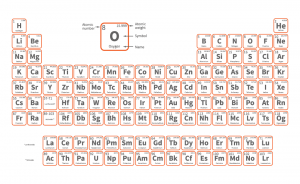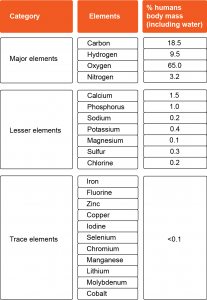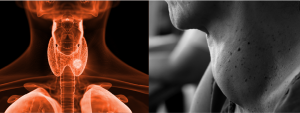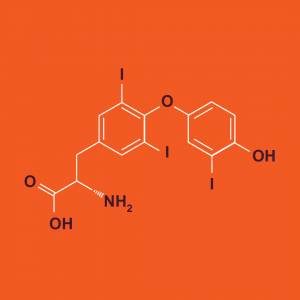Chapter 1: Atoms
Matter is anything that has mass and takes up space. All matter in the universe, including the human body, is made of atoms.
Atoms are composed of three subatomic particles: electrons, protons, and neutrons. Electrons are negatively charged and have negligible mass. Protons are positively-charged and neutrons have no charge but both protons and neutrons have measurable mass. The protons and neutrons reside in a dense central location called the atomic nucleus and the electrons surround the nucleus.
There are many models to describe atomic structure, including the Bohr model of the atom and the electron cloud model. The Bohr model proposes that electrons act like particles and surround the nucleus in discrete energy layers or electron shells (Figure 1). Every electron shell can accommodate a specific number of electrons or a specific amount of energy. This is because electrons move rapidly and, therefore, possess kinetic energy or the energy of movement. For example, the first shell is the energy shell closest to the nucleus. This shell can accommodate two electrons. The second and third shells can each accommodate a maximum of eight electrons. Some atoms have more than three electron shells but the atoms examined in this course will generally possess a maximum of three electron shells. The farther an electron is from the nucleus, the more energy that electron has. In other words, the outermost electron shell of an atom is the highest energy shell. Electrons fill the lowest energy or most stable shells first: the electron shells closest to the nucleus.
The electron cloud model proposes that electrons act like waves and their position can be described as a cloud around the nucleus. This course will not use the electron cloud model extensively but understanding the basic concept underlying this model will help you understand noncovalent interactions and more complex medical topics, such as medical imaging in your future studies.
Electrons determine the important properties and behaviour of atoms, especially when interacting with other atoms.

Elements are matter composed of only one type of atom and elements differ by the number of subatomic particles. Elements are identified by a unique atomic number. The atomic number corresponds to the number of protons in the nucleus. In an uncharged element, the number of protons (positive charges) is equal to the number of electrons (negative charges). The mass number of an element is the total number of protons and neutrons in the nucleus. The periodic table of elements organizes elements by increasing atomic number (left to right) and other atomic properties. For this course, you do not need to memorize the periodic table of elements.

Every organism has a unique set of essential elements or elements required for life. Humans require 25 essential elements; plants require 17 essential elements. Some essential elements are required in large amounts because they are common in our cells, such as carbon, hydrogen, oxygen, and nitrogen (Table 1). These are the major elements. Some essential elements are required in smaller quantities: the lesser elements. Some essential elements are required in minute quantities: the trace elements.
Table 1: Major, lesser, and trace elements of the human body.

Though trace elements are required in tiny amounts, there are serious consequences to deficiencies. For example, the recommended daily intake (RDI) of iodine is 150 micrograms (μg) for 19–30 year old adults who are not pregnant or breast-feeding. You can easily meet the RDI by using a small amount of iodized table salt on food or by consuming dairy or seafood.[1]. However, an iodine deficiency may result in an enlargement of the thyroid gland or goiter. The thyroid makes important hormones called T3 and T4 that contain many molecules of iodine in their structure. Without sufficient iodine, the thyroid enlarges to make more thyroid hormones to compensate for the low levels of T3 and T4.


Elements with the same atomic number but different mass numbers are called isotopes. These elements differ by the number of neutrons in the nucleus and some isotopes are commonly used for medical imaging or treatments. For example, iodine has an atomic number of 53 and a mass number of 127. An isotope of iodine, iodine-131, possesses four additional neutrons and is used to treat thyroid cancer.
Iodine-131 is also radioactive, meaning the atom is unstable and can emit radiation. Ionizing radiation is the emission of particles or waves that disrupt the structure of matter upon collision, resulting in damage to important cellular molecules such as DNA. For example, iodine-131 emits high energy electrons (beta emission) and a gamma ray. Gamma rays are high energy waves that can break double-stranded DNA and stop the cell from replicating or copying its DNA. This kills the cell.
Chemistry in the clinic:
Cancer is a complex disease but, for the purposes of Biology 1190, we can start by defining cancer as uncontrolled cell division. An individual with thyroid cancer suffers from uncontrolled cell division within the thyroid gland. To treat thyroid cancer, the patient is infused with iodine-131 in their blood. The blood carries the radioactive iodine-131 to the thyroid gland and the beta and gamma emissions of the radioactive isotope kill the cancerous thyroid cells. Some normal healthy cells may be killed or damaged by iodine-131 treatment. However, the damage may be repaired after treatment or that damage may be tolerated to kill the rapidly growing cancer. Iodine-131 is just one example of a medically useful radioactive isotope. Other radioactive isotopes are used to diagnose and to treat diseases and disorders.
Summary:
- All matter is made of atoms.
- Atoms are made of a nucleus containing protons and neutrons. Electrons surround the nucleus.
- Elements are matter made of one type of atom and have unique properties due to their unique atomic structures.
- Essential elements are elements that are necessary to support life.
- Major elements are required in large amounts; lesser elements are required in smaller amounts.
- Trace elements are required in very small amounts.
- Essential elements are elements that are necessary to support life.
- Elements play important roles in human health and medicine.
Resistance object has to forces
Greek for “indivisible”; the simplest unit of matter
Insufficient dietary intake of an essential element.
Emission of subatomic particles or waves, such as light waves.
To introduce substances such as drugs into the bloodstream

